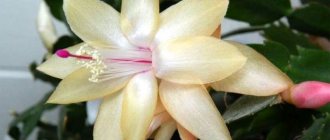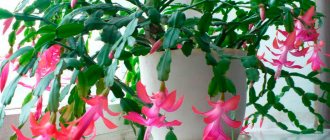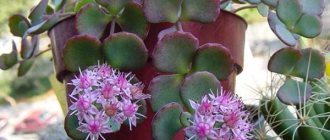Useful tips
- Are Decembrist's leaves turning red?
In winter, when it’s bitterly cold outside and everything is white with snow, when trees and bushes sleep in a snowy robe, and ruffled birds are diligently trying to get better shelter from the wind, it is at this moment that the wonderful winter flower Decembrist blooms.
This usually happens between November and December
. Hence the name of this flower, which colors the life of gardeners in the cold, winter cold with different summer colors.
Flower
This one is unpretentious
,
but in order for it to grow well and bloom profusely in winter, you need to know a few nuances about caring for this beautiful plant.
Varieties of zygocactus
Since Decembrist is a relative of cacti, thanks to the painstaking work of breeders, there are a large number of subspecies, which differ from each other in the shape of the bud, their color, and the shape of the segments:
- Madame Butterfly;
- Orsichiana;
- Mix;
- Golden cream;
- Aspen;
- Buckley;
- Rousseliana;
- Gartner;
- Microfaerica;
- Prickly pear;
- Laverdendall;
- Christmas fantasy, etc.
There are ampelous types of Decembrist flowers, in which case they are grown in hanging flower pots or in special devices so that the leaves fall freely. A relative of Schlumbergera is Rhipsalidopsis (Easter). It differs in flowering time - April-May.
Notes
- For the convention of indicating the class of dicotyledons as a superior taxon for the group of plants described in this article, see the section “APG Systems” of the article “Dicotyledons”.
- ↑ 1 2
Information about the genus
Schlumbergera
Index Nominum Genericorum
database of the International Association for Plant Taxonomy (IAPT). (Accessed: January 29, 2018) - ↑ 123456
Botany. Encyclopedia “All the Plants of the World”: Trans. from English = Botanica / ed. D. Grigoriev and others - M.: Könemann, 2006 (Russian edition). - P. 829. - 1020 p. — ISBN 3-8331-1621-8. - According to the GRIN
(see Links section). - ↑ 123456
Udalova, 1983. - RT Poole, LS Osborne and AR Chase University of Florida, IFAS Central Florida Research and Education Center - Apopka 2807 Binion Road., Apopka, FL 32703-8504.
Holiday Cactus Production Guide
(unspecified)
. - https://www.invasive.org/browse/detail.cfm?imgnum=5372598 (undefined)
. - https://negreenhouseupdate.info/photos/schlumbergera-drechslera-leaf-spot-and-stem-rot (unspecified)
(inaccessible link). Retrieved March 14, 2016. Archived October 25, 2022. - https://www.invasive.org/browse/detail.cfm?imgnum=5373286 (undefined)
. - List of species of the genus Schlumbergera (inaccessible link) according to the GRIN
(English) (Access date: November 12, 2009)
Signs and superstitions
Beliefs and predictions are associated with the Decembrist, as with other indoor plants:
- if flowering begins on time, relationships with relatives will improve;
- if it started earlier, new interesting acquaintances will appear;
- if at an atypical time, there will be a new addition to the family.
Rozhdestvennik is a donor who gives residents well-being, peace, and vitality.
Pollination
The peculiar structure of Decembrist flowers explains the plant’s inability to self-pollinate. The elongated flask-shaped shape of the flower consists of several joints strung on top of each other; a pistil emerges from the tips of the last flower, which is framed by stamens. In nature, zygocactus is cross-pollinated with the help of tropical hummingbirds. For this reason, Decembrist has an elongated stem shape; the plant’s homeland predetermines cross-pollination by birds and insects. After pollination, after some time, oval red fruits are formed at the ends of the branches.
Lighting
The Decembrist plant loves a bright place, but without direct burning rays. This means that it can be installed on all sides of the world except the north. To prevent the sun's rays from falling on the delicate leaves, shade them with something.
In summer, it is useful to take it out onto the balcony or loggia. Do not forget to rotate the pot around its axis to avoid one-sided distribution of the green mass.
In winter, it is advisable to use additional lighting with a fluorescent or LED lamp.
Common problems
*If you find brown spots on the leaves, the plant is affected by scale insects.
*If the plant stubbornly refuses to bloom, the room temperature is probably below 10 degrees.
*If Decembrist
dropped the upper segments of the shoots or the buds themselves - most likely the plant is experiencing drought or vice versa, waterlogging of the soil, as well as a change of location during the plant’s ovary. This can also happen if the plant is attacked by pests.
*If you find pale and sluggish shoots on a plant, then the likely cause is irregular watering, too much sun and pests.
*You saw light spots on the shoots of the plant - the plant is infected or there is an excess of light.
Watering
How to properly water a Decembrist flower? It needs abundant watering when buds set and flowering occurs (November-January), but such that moisture does not pour out through the drainage holes.
With such waterlogging, not only will the roots begin to rot, but also the microelements necessary for the formation of color will be washed out. During the rest of the period, water once a week, in the summer 2-3 times so that the soil surface has time to dry.
Many amateur gardeners use soil moistening through a tray; in this case, the soil does not lose its structure, microelements are not washed out when overwatered, the roots do not rot and absorb as much moisture as they need. The water should be either rainwater or centralized settled water.
Care after flowering
Sometimes you can see such a picture when a purchased flower can shed all its buds. And this is part of the standard process of adaptation to the changed conditions of the flower.
During the period of rest and rest, Decembrist
It is necessary to place it on the windowsill and provide it with light partial shade.
It should be close to the window, behind a transparent curtain. After flowering, the plant's stems can grow at temperatures up to 37 degrees. But the optimal temperature regime for Decembrist
is 18-25 degrees.
Temperature
Since zygocactus comes from the tropics, it loves air humidity and tolerates high temperatures. Therefore, tolerance ranges from 2°C to 40°C. It is unlikely that there will be such temperature changes in room mode.
The optimal temperature in winter and spring is 12-16°C, in summer – 18-26°C, during flowering 16-18°C. By showering, the leaves will not only be saturated with moisture, but the dust will also be washed away, and in the summer it will help to cool down. This procedure cannot be carried out only during flowering.
Links
- Media files on Wikimedia Commons
- Leaf cacti: epiphyllum and zygocactus
- Information about the different types of Schlumbergera (n.d.) (Date of access: November 23, 2009)
- The Schlumbergera flower is blooming. Video accelerated 1000 times
- Schlumbergera Hybrids. Schlumbergera hybrids (inaccessible link)
| Dictionaries and encyclopedias |
|
| Taxonomy |
|
The soil
The soil can be purchased either at a flower shop - soil for succulents (plants with fleshy stems), or you can make it yourself: mix equal parts compost, turf soil, sand, add vermiculite and ash.
Fertilizer
When caring for a plant, you need to know what to fertilize the Decembrist (flower). The homeland of the plant, where zygocacti lead a parasitic lifestyle, taking root on the trunks of tropical plants, provides the flowers with the necessary nutrients from the wood. Therefore, the plant is very unpretentious; regular cactus fertilizer is enough for it, which should be diluted by two quarters with water so as not to burn the delicate roots of the Decembrist.
Top dressing
Buy fertilizer for a given crop; if you don’t have one, then it will work for ordinary flowers, only in liquid form. In this case, feed not as written in the instructions, but diluted twice.
Feed in the spring - once a month, in the summer, during the formation of leaves - twice a month, in the fall, during preparation for budding - stop feeding. Instead, it is better to spray with some fungicide to prevent the formation of fungal diseases.
Following all the recommendations correctly:
- in the fall, stop frequent watering and fertilizing;
- three months before flowering, place in a cool, shaded place;
- in December, place in a well-lit place and start watering abundantly,
The Christmas lover should feel the signal and give color just in time for the “New Year”.
FAQ
Why doesn't the Decembrist bloom? The cause of the problem may be that the container is too large, and the plant will not bloom until its roots have taken over the entire space of the pot.
Sometimes the Decembrist refuses to bloom because the soil is not suitable for it. But usually the lack of flowering means that the plant does not have the necessary conditions for rest. At the end of September, move the Decembrist to a cool room, gradually reduce watering until it stops completely and do not fertilize. At the end of November, return the plant to its usual place and gradually resume the usual moisture regime.
The pot with the plant should be slightly rotated around its axis every day so that all shoots receive the same amount of light and develop evenly. But once bud formation begins, the plant cannot be moved or rotated, otherwise the Decembrist will drop the buds.
Keep the potting soil slightly moist.
If you do everything correctly, the Decembrist will definitely bloom. Why are there white spots on the Decembrist?
White spots on the segments of the Decembrist may appear from watering the plant with too cold water. Do not forget that indoor flowers need to be watered with settled water at room temperature, and some plants even require slightly warmed water.
White spots may appear on Decembrist leaves in winter if your windows have curtains that are too thick and do not allow room heat to reach the plant standing on a cold windowsill. Move the Decembrist to a warmer place, water it with Epin’s solution, and the plant will gradually warm up. While Schlumbergera is recovering, watering should be sparse. To prevent the Decembrist’s roots from freezing in the future, place a foam circle under the pot.
Mealybugs can also be mistaken for white spots, which can be gotten rid of with an insecticide, but you must first remove the pests from the leaves using a cotton swab, wash the Decembrist with warm water and allow it to dry.
The Decembrist is not growing - why?
The Decembrist generally takes a long time to grow, and if you have created all the necessary conditions for him, but he is in no hurry to develop, there is no need to worry. Decembrist loves cool air, so place it under a window so that when ventilating, fresh air from the street flows onto the plant, but there should be no drafts in the room.
You can stimulate the growth of the Decembrist with the help of a warm shower: wash the plant with warm, settled water once a week, and the result will not be long in coming. Make sure that the soil in the plant’s pot does not dry out and apply fertilizer in a timely manner.
Do not keep Decembrist in the kitchen: the temperature in this room often changes, and this instability has a bad effect on the plant.
And don’t forget about regular replanting: young Decembrists need to change the container and substrate once a year, and adults – once every five years. This plant needs a low but wide pot, since its root system is superficial. How to cut an overgrown Decembrist haircut?
To make the Decembrist look attractive, it needs to be pruned, and this should be done in the first month of spring, when the plant enters a period of active growth. You can carry out the procedure at another time, but not earlier than a month after the end of flowering: cutting during the formation of buds and flowers will lead to the Decembrist dropping them and will not bloom this year.
Pruning not only gives the Decembrist a well-groomed appearance, but also stimulates abundant flowering and also prolongs the life of the plant. Actually, although this process is called pruning, it is actually carried out manually: you simply pinch off with your hands those segments that seem unnecessary to you. Using any sharp instrument can harm the plant.
Hold the lower segment with one hand and use the other to turn the upper segment clockwise until it separates.
The segments remaining after pruning can be used for propagation. How often to replant Decembrist?
Transplanting Decembrist is a mandatory procedure that prolongs the life of the plant. Young Decembrists should be replanted every year, and starting from the age of four - once every four years. A plant that is not transplanted in due time will begin to wither, wither, and eventually die.
The best time for replanting is spring, when Schlumbergera begins a period of active growth. Observe the plant, and as soon as young segments begin to appear on it, you can begin replanting.
The pot for the Decembrist should not be deep, since the roots of this plant are superficial, but the container must be stable and wide enough.
Drainage material should occupy at least a third of the volume of the pot. Store-bought soil for cacti is suitable as a substrate, but you can make a soil mixture yourself from equal parts of leaf soil, sand, turf soil, adding a quarter of humus to it. Why does the Decembrist shed its buds?
This usually happens if the flower pot is turned or moved from place to place during bud formation. The plant cannot be moved at this time. But sometimes the loss of buds is caused by the wrong location or improper conditions.
We remind you: the best place for a zygocactus is an eastern window, but if your windows face west or south, be sure to shade the Decembrist with a curtain from bright sunlight, because you are dealing with a forest cactus that prefers diffused light.
Do not expose the Decembrist to sudden temperature changes and do not keep it in a draft.
The plant's dormant period should be cool at 12-16 ⁰C. During the period of active growth, the plant is comfortable at a temperature of 18-24 ⁰C, and when flowering begins, it is advisable to lower the temperature to 18-20 ⁰C. The heat is not conducive to Decembrist flowering, so in winter, protect it from the hot air coming from heaters. How to water and fertilize Decembrist so that it blooms?
From November to February inclusive, the Schlumbergera soil should be moistened weekly, and so much so that the earthen ball is soaked through with moisture. Actually, the frequency of watering depends on the conditions of maintenance: in a warm room you will have to water more often, but in a cool winter the soil dries out much more slowly. Watering is carried out when the substrate in the pot dries to two-thirds of the depth, and the shoots of the plant begin to wrinkle. The water should be no colder than room temperature, and it should be left for at least a day.
As soon as the buds begin to form, add fertilizer to the soil once every 2-3 weeks, but be careful: it is better not to fertilize the Decembrist at all than to overfeed it.
For abundant flowering, Schlumbergera requires calcium and phosphorus.
The best choice is fertilizer for flowering plants or a complex for cacti and succulents. Sometimes water the soil with a solution of 1 teaspoon of castor oil in 1 liter of water. The Decembrist has limp leaves - what to do?
The reasons for this unpleasant phenomenon can be: the plant is affected by a disease or its roots die for some reason. The most dangerous diseases are fusarium, late blight and phytium. These fungal infections prevent the Decembrist leaves from supplying moisture, which is why they become lethargic and soft.
Pay attention to the root collar of the plant and if damage is detected, immediately begin treatment. If the pathology has not yet affected the roots, the plant can be saved with Fitosporin-M, Maxim, Topaz or Skor. But if the soil is infected with a fungus, the plant will have to be replanted. When replanting, pay attention to the roots and get rid of rotting areas.
If the wilting of the leaves is caused by the death of the roots, replanting the plant will not save it.
The only thing you can do is to take Decembrist cuttings and grow a new plant from its segments: Schlumbergeras take root easily even in flaccid segments. Is it possible to grow Decembrist from an almost withered leaf?
Reproduction of Decembrist by segments is the simplest and therefore the most popular method. Even a flaccid segment of the stem is suitable for this. There have been cases when a dried segment lying in a bag successfully took root.
It is necessary to separate the segment for propagation when the Decembrist plant is not blooming, otherwise the plant may behave as if in a stressful situation: it will begin to shed flowers and buds. Before planting, the cutting should lie in a dark place for two days.
It is still desirable that the cuttings consist of 2-3 segments: longer cuttings are inconvenient to work with. Part of the stem is planted in loose peat-based soil, the pH of which should be in the range of 5-6.5 units. As a container, you can use a plastic cup or pot with a volume of up to 200 ml. The dishes must have drainage holes.
Place a layer of perlite, expanded clay or other drainage material on the bottom of the cup, fill the container with substrate and stick the cutting into it.
Is Decembrist dangerous for pets and children?
Decembrist is not a poisonous plant, so it is not dangerous for children. But in pets that chew the leaves of the plant, swelling of the larynx or indigestion may occur, and in people suffering from asthma, Schlumbergera can cause breathing difficulties.
Neither official nor traditional medicine has discovered healing properties in Decembrist, but it purifies the air from harmful chemicals emitted by interior items made of plastic and synthetics, and saturates the room with oxygen. In addition, the Decembrist absorbs electromagnetic radiation.
This plant is simply intended for a psychologist’s office: it makes people want to communicate and share their secrets.
Astrologers claim that zygocactus is able to extinguish aggression and helps get rid of bad intentions. However, women are not recommended to keep this flower in the house, since there is an opinion that it belongs to the category of “husband-killers”. How to divide a Decembrist plant?
Typically, Decembrist is propagated by cuttings, but an overgrown bush can be divided into parts and immediately obtain at least two adult plants. Division is carried out simultaneously with transplantation or at any time after the end of the flowering period, but the best season for this procedure is spring.
Remove the Decembrist from the pot, remove old and flabby shoots, carefully untangle the roots, cut the rhizome with a sharp sterile knife, sprinkle the sections with charcoal powder and plant the cuttings in different pots with fresh loose soil.
Sometimes, when the rhizome is exposed, you can find rotten areas on it. Carefully cut out the rot, grabbing healthy tissue, treat the wounds with a solution of fungicide or potassium permanganate, and only then divide the root and plant the divisions.
It is likely that after this painful procedure, the Decembrists will be sick for some time, but eventually they will adapt and begin to develop.
How to restore a frozen Decembrist?
Decembrist is a tropical plant, so prolonged exposure to temperatures of 16 ⁰C and below can lead to irreversible consequences. If the shoots of a frozen Decembrist have not yet become watery, it can be saved, but in this case it is very important not to change the conditions of the plant too abruptly: this will cause it even more harm.
Place the Decembrist in a bright room in which the temperature does not rise above 18 ⁰C, and prevent the appearance of drafts. Provide bright, diffused light, spray with Epin solution, but under no circumstances water the plant. Over time, the Decembrist will come to life, and fresh segments will begin to appear on it, and then buds.
But if the roots of the plant have already died from the cold, try to save it by rooting cuttings separated from the stems, 2-3 segments long. You can root the segments in water (the roots grow within two weeks) or directly in soil for cacti and succulents.
Reproduction
Schlumbergera is propagated in two ways - cuttings and seeds.
Propagation by cuttings
The preferred time for reproduction is spring and summer. The method of propagation by cuttings is very simple and unpretentious.
You just need to unscrew a leaf with two or three segments from the main plant, deepen it into moist soil, cover it with film, make holes in it for ventilation and place it in a warm, bright place. To accelerate the formation of roots, you can use rootin or zircon.
As soon as a new segment begins to appear, the cuttings have taken root and are ready to be transplanted into a pot. You can propagate the plant differently by placing the cuttings in a glass of water and waiting for the roots to appear before transplanting them to a permanent place of growth.
Propagation by seeds
In the wild, Schlumbergera flowers are pollinated by insects, after which an ovary is formed and a pink, pear-shaped fruit about two centimeters in length grows. This edible berry stays on the segment until the next flowering, gradually ripening. It tastes sour, birds eat it, and spread the seeds around with excrement.
No matter how good the care is, you cannot get seeds in indoor conditions. Therefore, purchased seeds are used. Having planted them in moist soil and covered them with a film with holes for ventilation, wait for them to sprout. The period varies from 20 days to several months. When shoots appear, wait until they get stronger, and then transplant them into pots.
Description of the succulent
The Christmas cactus has erect and drooping stems that grow up to 15-30 cm in length; the leaves consist of 5-6 cm segments. Each segment has jagged edges. The stems are flat, fleshy, clearly divided into sections, at the ends of which flowers appear up to 10 centimeters long.
Flowers with curved perianth petals of varying lengths, arranged in 2 spaced rows, creating the impression of a short fragment of a garland. Flowers are white, red, pink, yellow.
The Schlumbergera cactus usually grows alone in a pot, but can be planted in a large container with other cacti.
Zygocactus belongs to the cactus family (lat. Cactaceae), but does not behave like a typical cactus. Decembrist has no thorns or spines, but thin dark bristles may appear at the top of its dark green, shiny, leaf-shaped shoots.
Decembrist belongs to the succulent family. Plants of this type are characterized by thick, fleshy stems that store water. Succulents owe their resistance to environmental conditions to their original forms. Although they take different forms, the structure of their leaves, shoots and roots does not differ. The fabrics allow water to accumulate, which protects against environmental damage during droughts. Zygocactus stores water in its stems, shoots and roots, thanks to which it can survive in very unfavorable conditions.
Reference. Succulents grow all over the world - in Europe, Asia, America. They include a diverse group of plants, from tiny aquatic species to giant woody desert cacti. Succulents love light soil with added sand. Growing and caring for succulents is undemanding; they are usually propagated by cuttings. All succulents are usually planted shallow in a pot. Most of the group consists of cacti. Cacti differ from other succulents in that they have growth cones and so-called halos, that is, covered with hairs or down, round or elongated places from which thorns, side shoots, and flowers grow.
Disease Control
If the leaves have lost their healthy shine, become pale, lost their elasticity, and segments have begun to fall off, this means the plant is sick.
- Fungal diseases such as phytium, fusarium, late blight could provoke these symptoms. These diseases are treated with fungicides. It is necessary to transplant the flower into healthy soil, having previously treated the roots with a disinfectant (for example, a solution of potassium permanganate).
- Overdried roots could also provoke this series of symptoms.
- The plant could have suffered stress - a large temperature difference, a draft, or moving from a store to a home.
- Overfeeding or lack of microelements.
- Overwatering.
If the Decembrist is provided with proper care, then every “New Year” he will give the owners a bouquet of Christmas flowers.
From the rainforest to the windowsill
Decembrist is a popular plant belonging to the genus Schlumbergera (lat.). Until the early 90s it was part of the genus Zygokaktus, and this name can still be found. In fact, the correct name for this attractive and very popular plant is Schlumbergera trunctata. The name was given in honor of the Frenchman Frederic Schlumberger, who lived in the 19th century, a famous collector and cultivator of cacti. On the other hand, the plant owes the term “Decembrist” to its unusual winter flowering season.
People buy this flower as a New Year's decoration or gift. Zygocactus is a long-lived plant that grows for 10-20 years in an apartment. However, you need to know how to grow it so that it maintains a festive mood for many years.
The Christmas cactus originates from Brazil. The plant is an epiphyte, that is, it grows on the crowns of tropical trees. Decembrist shoots can hang freely from trees up to several tens of centimeters! Sometimes this flower also grows on rocks covered with vegetation (in rock cavities). It was supposedly a garden plant once cultivated by local tribes.
Zygocactus came to Europe in the 19th century and almost immediately became a favorite flower. After a period of slight oblivion, this plant returned to the windowsills. In winter it beautifully decorates apartments with bright flowers, and in summer it grows on balconies, terraces or even directly on flower beds.
Photo of houseplant Decembrist
Priming
The soil must allow moisture and air to pass through. If you make the soil yourself, the base is sand and leaf humus in equal proportions.
You can add a little charcoal or peat. A no-fuss option is a universal primer. The soil is not suitable for cacti (excess peat).
How does pruning happen?
For pruning, no tools are needed except the caring hands of the housewife. You should hold the sheet from below and make twisting movements. The leaf segments come off easily.
If the plant is many years old, some leaves will branch in two directions, forming the English letter Y. To trim them, you need to leave 1 segment of the branch on each side.
This is interesting: After pruning, the flower can bloom again in March.
Peculiarities
The main advantage of this unusual cactus is its ability to bloom all year round. But you will need to carry out care measures. Problems may also arise due to the need to change temperature and humidity.
Zygocactus flower: home care
But if you take into account a few additional tips, all the disadvantages can be minimized:
- You should not place the cactus on a western or southern windowsill. These areas usually have the brightest lighting.
- In summer, the plant should be well ventilated. But you need to avoid places where fungi from other plants (for example, those that neighbors have or in the yard) can reach the cactus.
- If the humidity is low, then you can periodically put the zygocactus in the shower.
If you follow all the recommendations, the zygocactus will delight you with numerous flowers. At home, it can live for several decades. And if you graft it onto another plant, it will become much more magnificent. The main thing is to monitor soil moisture and the frequency of watering and fertilizing.











